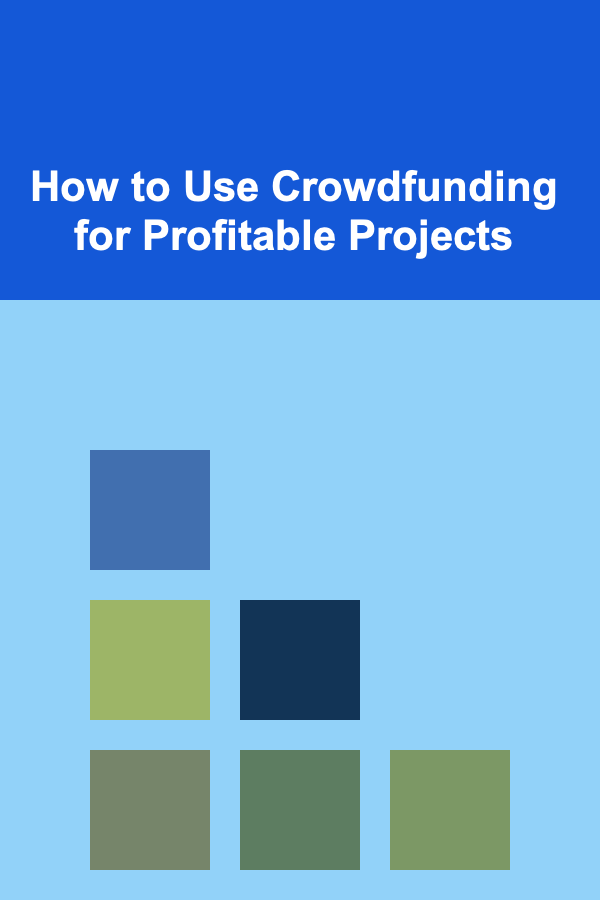
How to Use Crowdfunding for Profitable Projects
ebook include PDF & Audio bundle (Micro Guide)
$12.99$6.99
Limited Time Offer! Order within the next:

Crowdfunding has revolutionized the way entrepreneurs and creators finance their projects. It allows individuals to raise capital from a large audience, bypassing traditional gatekeepers like banks and venture capitalists. While crowdfunding offers immense potential, launching a successful and profitable campaign requires careful planning, strategic execution, and a deep understanding of its nuances. This article delves into the intricacies of using crowdfunding to fund projects that not only reach their funding goals but also pave the way for long-term profitability.
I. Understanding the Crowdfunding Landscape
Before embarking on a crowdfunding journey, it's crucial to grasp the diverse landscape of platforms and funding models. Each platform caters to different niches and has its own strengths and weaknesses. Furthermore, choosing the right funding model is critical to aligning your project with your financial goals and your audience's expectations.
A. Types of Crowdfunding Platforms
The crowdfunding ecosystem encompasses various platforms, each specializing in different categories and attracting different types of backers. Here's a breakdown of some of the most prominent platforms:
- Kickstarter: Known for creative projects, including art, design, film, music, and games. It operates on an all-or-nothing model, meaning you only receive the funds if you reach your funding goal.
- Indiegogo: Offers more flexibility than Kickstarter, allowing you to keep the funds raised even if you don't reach your goal (flexible funding). It's popular for a wide range of projects, including technology, social causes, and creative endeavors.
- GoFundMe: Primarily used for personal causes, charities, and medical expenses. It's known for its ease of use and wide reach.
- Patreon: A membership-based platform where creators can receive recurring funding from their fans in exchange for exclusive content and rewards. Ideal for artists, writers, and musicians who produce consistent content.
- Seedrs & Crowdcube: Equity crowdfunding platforms where backers invest in your company in exchange for equity. This is a more complex option that requires a strong business plan and legal compliance.
- Republic: Another equity crowdfunding platform, similar to Seedrs and Crowdcube, but with a focus on making investing more accessible to a wider range of people.
When choosing a platform, consider the following factors:
- Your Project Category: Does the platform specialize in your niche?
- Target Audience: Does the platform attract the type of backers you're looking for?
- Fees: What are the platform's fees and payment processing charges?
- Funding Model: Does the platform offer the funding model that best suits your project?
- Community and Support: Does the platform offer a strong community and helpful support resources?
B. Different Crowdfunding Models
Different crowdfunding models offer varying levels of flexibility and risk. Understanding these models is essential for selecting the one that aligns with your project's needs and your risk tolerance.
- All-or-Nothing (Fixed Funding): You only receive the funds if you reach your funding goal. This is the most common model on Kickstarter and is generally considered safer for backers, as they are not charged unless the project is successfully funded. This also motivates project creators to work hard to achieve their goal.
- Keep-What-You-Get (Flexible Funding): You receive the funds raised regardless of whether you reach your funding goal. This is offered by Indiegogo and can be beneficial if you need some funding to get started, even if you don't reach your full target. However, it can also create challenges if you don't raise enough to deliver on your promises.
- Equity Crowdfunding: Backers receive equity in your company in exchange for their investment. This is a more complex model that requires careful legal compliance and a strong business plan. Platforms like Seedrs, Crowdcube, and Republic facilitate equity crowdfunding.
- Donation-Based Crowdfunding: Backers donate to your project without expecting anything in return. This is commonly used for charitable causes and personal emergencies.
- Rewards-Based Crowdfunding: Backers receive rewards in exchange for their contributions. These rewards can range from early access to your product to exclusive merchandise or experiences. This is the most common model for creative projects and product launches.
- Subscription Crowdfunding: Backers pay a recurring fee to support your ongoing work. This is suitable for creators who produce consistent content, such as writers, musicians, and podcasters. Patreon is a popular platform for subscription crowdfunding.
II. Crafting a Compelling Crowdfunding Campaign
The success of your crowdfunding campaign hinges on creating a compelling narrative, offering enticing rewards, and building a strong community around your project. A well-crafted campaign will resonate with potential backers and inspire them to support your vision.
A. Defining Your Project and Funding Goal
Before launching your campaign, clearly define your project, its scope, and its intended impact. Articulate what problem you're solving, what need you're fulfilling, and why your project is unique and valuable. Then, determine the exact amount of funding you need to bring your project to life.
- Project Scope: What are the specific deliverables of your project? What are the key milestones you need to achieve?
- Problem/Need: What problem are you solving with your project? What need are you fulfilling?
- Uniqueness: What makes your project unique and different from other similar projects?
- Value Proposition: Why should people care about your project? What benefits will they receive from supporting it?
Your funding goal should be realistic and based on a detailed budget that covers all your expenses, including:
- Production Costs: Materials, manufacturing, equipment.
- Development Costs: Software development, research, design.
- Marketing and Advertising: Campaign promotion, social media advertising, public relations.
- Fulfillment Costs: Shipping, packaging, handling.
- Platform Fees: Fees charged by the crowdfunding platform.
- Payment Processing Fees: Fees charged by payment processors.
- Contingency Fund: A buffer for unexpected expenses.
Underestimating your funding needs can lead to project delays, compromised quality, and ultimately, failure to deliver on your promises. It's better to overestimate slightly and have some breathing room than to run out of funds before completing your project.
B. Creating a Captivating Campaign Page
Your campaign page is your storefront on the crowdfunding platform. It's where you tell your story, showcase your project, and convince potential backers to contribute. Make sure your page is visually appealing, informative, and persuasive.
- Compelling Video: A short, engaging video is essential. It should introduce you, your team, and your project. Show the problem you're solving and how your project will solve it. Include testimonials if possible. Keep it concise (under 3 minutes) and visually appealing.
- High-Quality Images: Use professional-quality images and graphics to showcase your project. Show prototypes, mockups, and examples of your work.
- Detailed Description: Write a clear and concise description of your project. Highlight its key features, benefits, and unique selling points. Tell a story that connects with your audience emotionally.
- Rewards Tiers: Offer a variety of rewards tiers to appeal to different levels of backers. Make sure the rewards are desirable, relevant, and worth the contribution. Consider early bird specials and limited-edition rewards to create a sense of urgency.
- Team Introduction: Introduce yourself and your team. Highlight your expertise, experience, and passion for the project. This builds trust and credibility.
- Timeline: Clearly outline your project timeline, including key milestones and estimated delivery dates. This shows backers that you have a plan and are committed to delivering on your promises.
- Frequently Asked Questions (FAQ): Address common questions and concerns about your project. This helps alleviate any doubts and encourages potential backers to contribute.
- Call to Action: Clearly state what you want backers to do -- contribute to your campaign. Make it easy for them to donate by prominently displaying the contribution button.
C. Offering Irresistible Rewards
Rewards are a key incentive for backers to contribute to your campaign. They should be relevant to your project, appealing to your target audience, and priced appropriately. Think creatively and offer a range of rewards to cater to different levels of support.
Consider these reward ideas:
- Early Bird Discounts: Offer discounted pricing for the first backers who contribute.
- Exclusive Access: Provide early access to your product or service.
- Limited-Edition Items: Offer exclusive merchandise or experiences that are only available to backers.
- Personalized Thank You Notes: Show your appreciation with handwritten thank you notes.
- Name Recognition: Acknowledge backers by name on your website or in your product credits.
- Behind-the-Scenes Content: Share exclusive behind-the-scenes content with your backers.
- Product Bundles: Offer bundles of your product or service at a discounted price.
- Experiences: Offer unique experiences, such as workshops, meet-and-greets, or private events.
- Customized Products: Allow backers to customize your product to their specifications.
When designing your rewards tiers, consider the following factors:
- Cost: Ensure that your rewards are profitable, taking into account the cost of production, fulfillment, and shipping.
- Value: Make sure the rewards are worth the contribution. Backers should feel like they're getting a good deal.
- Relevance: The rewards should be relevant to your project and appeal to your target audience.
- Fulfillment: Ensure that you can fulfill your rewards on time and within budget.
III. Promoting Your Crowdfunding Campaign
Building a successful crowdfunding campaign requires proactive promotion and consistent engagement with your audience. Simply launching your campaign and hoping for the best is not enough. You need to actively reach out to potential backers, build awareness, and generate excitement around your project.
A. Building a Pre-Launch Audience
Before launching your campaign, build a pre-launch audience of potential backers. This will give you a head start and increase your chances of reaching your funding goal.
- Email List: Start building an email list of interested individuals. Offer a free incentive, such as a discount or exclusive content, in exchange for their email address.
- Social Media: Create a social media presence on platforms relevant to your target audience. Share updates, behind-the-scenes content, and teasers about your project.
- Website/Blog: Create a website or blog for your project. This will serve as a central hub for information and updates.
- Press Outreach: Reach out to journalists, bloggers, and influencers in your niche. Pitch them your story and ask them to cover your project.
- Networking: Attend industry events and networking opportunities. Connect with potential backers and spread the word about your project.
B. Leveraging Social Media
Social media is a powerful tool for promoting your crowdfunding campaign. Use it to build awareness, engage with your audience, and drive traffic to your campaign page.
- Consistent Posting: Post regularly on social media. Share updates, behind-the-scenes content, and reminders about your campaign.
- Engaging Content: Create engaging content that resonates with your audience. Use visuals, videos, and interactive elements to capture their attention.
- Hashtags: Use relevant hashtags to increase the visibility of your posts.
- Paid Advertising: Consider using paid advertising on social media to reach a wider audience. Target your ads to individuals who are likely to be interested in your project.
- Social Media Contests: Run social media contests to generate excitement and engagement.
- Influencer Marketing: Partner with influencers in your niche to promote your campaign to their followers.
C. Email Marketing Strategies
Email marketing is an effective way to communicate with your pre-launch audience and keep them updated on your campaign. Use email to announce your launch, share updates, and encourage backers to contribute.
- Welcome Email: Send a welcome email to new subscribers to your email list. Introduce yourself and your project, and explain why they should support your campaign.
- Launch Announcement: Announce the launch of your campaign to your email list. Provide a link to your campaign page and explain why they should contribute.
- Update Emails: Send regular update emails to keep your subscribers informed about the progress of your campaign. Share milestones, new rewards, and behind-the-scenes content.
- Thank You Emails: Send thank you emails to backers who contribute to your campaign. Express your appreciation for their support.
- Reminder Emails: Send reminder emails towards the end of your campaign to encourage backers to contribute before the deadline.
D. Public Relations and Media Outreach
Generating media coverage can significantly boost your campaign's visibility and credibility. Reach out to journalists, bloggers, and influencers in your niche and pitch them your story.
- Press Release: Write a compelling press release about your project and distribute it to media outlets.
- Media Kit: Create a media kit that includes information about your project, your team, and high-quality images and videos.
- Targeted Outreach: Identify journalists, bloggers, and influencers who are likely to be interested in your project and reach out to them directly.
- Offer Exclusive Content: Offer exclusive content or interviews to media outlets in exchange for coverage.
IV. Managing Your Crowdfunding Campaign
Launching your campaign is just the beginning. You need to actively manage your campaign, respond to questions and comments, and keep your backers engaged. This includes monitoring progress, addressing concerns, and adapting your strategy as needed.
A. Monitoring Campaign Progress
Track your campaign's progress daily. Monitor your funding levels, website traffic, social media engagement, and media coverage. This will help you identify what's working and what's not.
- Funding Levels: Monitor your funding levels to see how close you are to reaching your goal.
- Website Traffic: Track your website traffic to see how many people are visiting your campaign page.
- Social Media Engagement: Monitor your social media engagement to see how many people are liking, sharing, and commenting on your posts.
- Media Coverage: Track your media coverage to see how many media outlets are covering your project.
B. Engaging with Backers
Respond to questions and comments promptly and professionally. Show your appreciation for your backers' support. Build a strong community around your project.
- Respond to Comments: Respond to comments on your campaign page and social media channels promptly and professionally.
- Answer Questions: Answer questions about your project thoroughly and accurately.
- Show Appreciation: Express your appreciation for your backers' support. Thank them for their contributions.
- Build Community: Foster a sense of community among your backers. Encourage them to connect with each other.
C. Adapting Your Strategy
Be prepared to adapt your strategy based on the results you're seeing. If something isn't working, don't be afraid to change it. Try new marketing tactics, adjust your rewards tiers, or revise your messaging.
- Analyze Data: Analyze your campaign data to identify what's working and what's not.
- Experiment with New Tactics: Experiment with new marketing tactics to see if they can improve your results.
- Adjust Rewards Tiers: Adjust your rewards tiers based on backer feedback.
- Revise Messaging: Revise your messaging to make it more compelling and persuasive.
D. Handling Challenges and Setbacks
Expect challenges and setbacks. Crowdfunding campaigns are not always smooth sailing. Be prepared to handle criticism, delays, and unexpected expenses.
- Address Criticism: Address criticism constructively and professionally.
- Manage Delays: Communicate delays to your backers promptly and transparently. Explain the reasons for the delays and provide a revised timeline.
- Handle Unexpected Expenses: Have a contingency fund in place to cover unexpected expenses.
V. From Crowdfunding to Profitability: Building a Sustainable Business
Successfully funding your project is a significant achievement, but it's just the first step. The ultimate goal is to transform your crowdfunded project into a profitable and sustainable business. This requires careful planning, strategic execution, and a long-term vision.
A. Fulfilling Promises and Delivering Rewards
The most critical aspect of building trust and establishing long-term profitability is fulfilling your promises and delivering rewards on time and as promised. Failure to do so can damage your reputation and jeopardize your future business prospects.
- Prioritize Fulfillment: Make fulfillment a top priority. Dedicate the necessary resources and personnel to ensure that rewards are delivered efficiently and accurately.
- Communicate Regularly: Keep your backers informed about the progress of fulfillment. Provide regular updates and address any concerns promptly.
- Quality Control: Ensure that the rewards you deliver meet the quality standards you promised. Don't compromise on quality to save money.
- Go the Extra Mile: Consider adding a small bonus or surprise to your rewards packages to delight your backers.
B. Building a Brand and Community
Your crowdfunding campaign provides a valuable opportunity to build a brand and cultivate a loyal community around your project. Nurture this community and leverage it to drive future sales and growth.
- Maintain Communication: Continue to communicate with your backers even after the campaign has ended. Keep them updated on your progress and solicit their feedback.
- Create Exclusive Content: Offer exclusive content and experiences to your backers as a reward for their loyalty.
- Host Events: Host events, both online and offline, to bring your community together.
- Solicit Feedback: Actively solicit feedback from your community to improve your product or service.
C. Developing a Sustainable Business Model
Develop a sustainable business model that generates recurring revenue and ensures long-term profitability. Don't rely solely on crowdfunding for funding. Explore other revenue streams, such as subscriptions, partnerships, and licensing agreements.
- Recurring Revenue: Develop a business model that generates recurring revenue, such as subscriptions or memberships.
- Partnerships: Partner with other businesses to expand your reach and generate new revenue streams.
- Licensing Agreements: License your technology or intellectual property to other companies.
- Explore Other Funding Options: Consider seeking venture capital or angel investment to further scale your business.
D. Measuring and Analyzing Results
Continuously measure and analyze your business results to identify what's working and what's not. Track key metrics, such as sales, customer acquisition cost, and customer lifetime value.
- Sales: Track your sales revenue to see how well your product or service is performing.
- Customer Acquisition Cost (CAC): Calculate your customer acquisition cost to see how much it costs to acquire a new customer.
- Customer Lifetime Value (CLTV): Calculate your customer lifetime value to see how much revenue you can expect to generate from a customer over the course of their relationship with your business.
- Analyze Data: Analyze your data to identify areas for improvement and make data-driven decisions.
By carefully planning your campaign, engaging with your backers, and building a sustainable business model, you can transform your crowdfunding project into a thriving and profitable enterprise. Crowdfunding is not just a way to raise money; it's a launchpad for innovation, creativity, and entrepreneurial success.

How to Manage Your Small Business Finances Effectively
Read More
How to Organize Your Kitchen for Better Storage Efficiency
Read More
How to Renovate Your Basement and Add Extra Living Space
Read More
Saving on Home Energy Bills: A Complete Guide to Reducing Your Monthly Expenses
Read More
Smart Discount Shopping: How to Save More on Every Purchase
Read More
How to Create a Social Media Checklist for E-commerce
Read MoreOther Products

How to Manage Your Small Business Finances Effectively
Read More
How to Organize Your Kitchen for Better Storage Efficiency
Read More
How to Renovate Your Basement and Add Extra Living Space
Read More
Saving on Home Energy Bills: A Complete Guide to Reducing Your Monthly Expenses
Read More
Smart Discount Shopping: How to Save More on Every Purchase
Read More